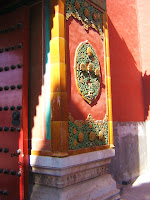
The works of Mark Hix
Like Jack Vettriano, Séraphine Louis and Henri Rousseau, Philadelphia-born artist Mark Hix is self-taught. His collection of art work, including oil paintings, works on wood, mixed media, and drawings, can be viewed at Bleicher/Golightly Gallery in Santa Monica in June 2010. Influenced by contemporary, neo-expressionist and independent artists, Hix’s works are a reflection of his life experiences and spiritual growth, created in his downtown Los Angeles studio at the Brewery Arts Complex.
What stands out most are his portrait paintings from “series paintings 1,” made of thick layers of oil paint. Among them are writers from the Beat Generation, Alan Ginsberg, Willam S. Burroughs and Jack Kerouac. “More than being fascinated by the Beats,” Hix explained “I’m fascinated with individuals that are desperate to be heard and brave enough to try.” Furthermore, the 46-year-old emerging artist did a series on American folk singers, including Bob Dylan and Woody Guthrie. “Although I appreciate American folk music, I’m more interested in who they were and what they did - ambitious restless souls.”
Although it might occur that Hix paintings carry political statements, especially in his portrait paintings of Sitting Bull, he looks at them more from a general philosophical perspective. “There was someone that stood in the face of enormous opposition, unwilling to let go of his principles.” For portrait paintings, Hix doesn’t use life models, but photographs. He mostly works with a palette knife and developed a unique technique by painting his works upside-down. “It helps me to focus on shapes and values,” he said.
One of his paintings “The Journey,” from “series paintings 2” shows a mostly black and white image with an elderly man, walking over a bridge in a winter landscape. Hix emphasized that “The Journey” is a metaphor for life. “The individual aged, still continues on his path alone,” he said, “making his way through the dense cold brush and trees of the forest (nature). There is a strange comfort there.”
Two of Hix’ paintings “After Cezanne” and “After Van Gogh” - the one showing a still life, the other a landscape - are studies and copies of works by Cezanne and Van Gogh. “After Cezanne” was inspired by Cezanne’s “Still Life with Red Onions,” although a cropped version of it, “After Van Gogh” by Van Gogh’s “A wind-beaten tree.” However, they’re not an homage to these renown painters, “but simply exercises,” he said. Whereas his copies look as if they were made by brush strokes similar to the originals, Hix stressed that he only used a brush to draw and lay them out. Only sometimes he went back and cleaned something up with the brush, yet he never models or blends with it.
Despite the fact, Hix has worked primarily on paintings in recent years, he likes to stay flexible.
His earlier work consists of a series of mixed media pieces - made out of burlap, plaster, oil paint, sometimes using photos and other objects. His piece “Moonlit,” an image mostly in blues and purples with a silhouette, is from his series “Shadow Figures”. The line of the Silhouette is created by the quick application of the plaster onto the burlap. “This allows me to create an illusion of depth in a new way,” he said.
Hix’ works on wood appear to have had an Asian influence. One piece called “Tree on a Hill” shows a tree on a slope that’s firmly rooted, but slightly crooked. There are three areas in the painting, where the wood is exposed, which are meant to project a metamorphosis. “In my eyes, they are romantic pieces,” he added.
Hix also has a collection of drawings, which depict speople he admires, Cezanne, Keaton, Modigliani and Thoreau. They were drawn upside-down like his paintings - with an ink pen, fast and free.
By Simone Kussatz
All content of this site © belongs to Simone Kussatz
.JPG)

.JPG)



.JPG)
.JPG)


















